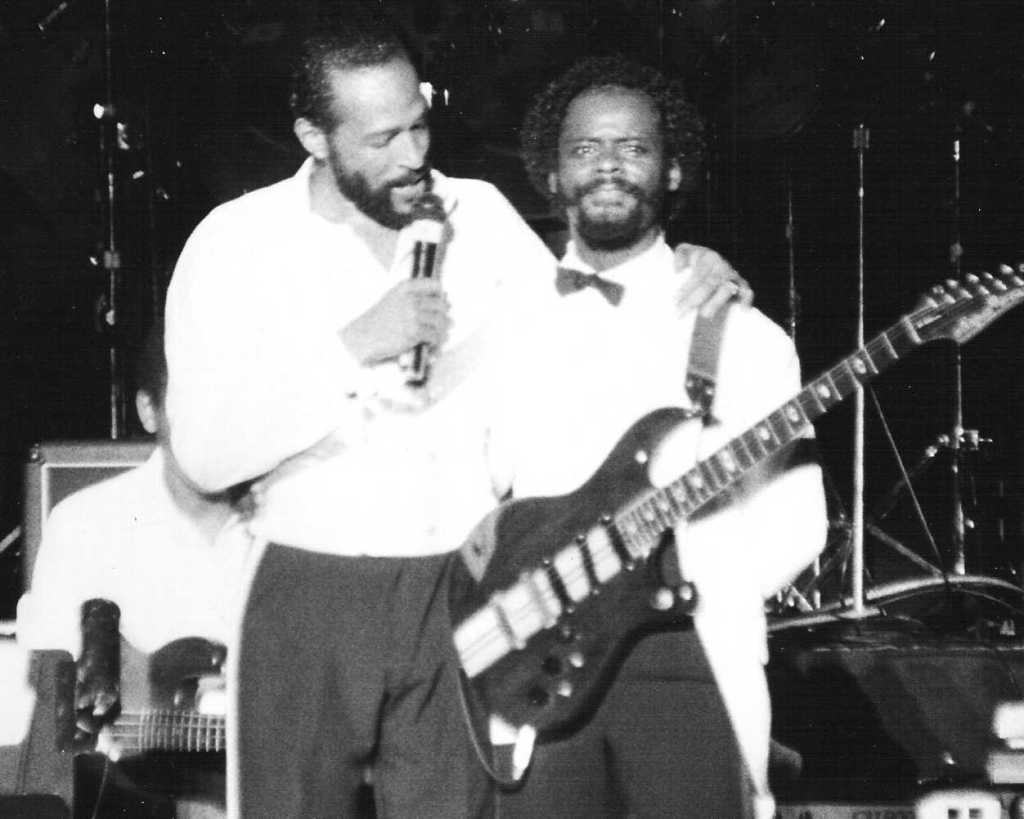In the Songs of Solomon, the act of how to treat your woman prior to and in the act of making love is expressed poetically in the Bible’s Old Testament. It talks of the spiritual side of sex, describing the physical act as a holy covenant between man and bride.
The adjacency of sex and religion has been taboo in Christian circles, particularly in the 20th century. However, singer/songwriter Marvin Gaye sought to reclaim the holy amalgamation between the spirit and the flesh throughout his career, particularly after falling in love with his future second wife, Janis Hunter during the sessions for what would become 1973’s Let’s Get It On.
However, Gaye had a conflicting viewpoint of women and sex in his personal life. From his first Motown hit “Stubborn Kind of Fellow” all the way to “Sexual Healing,” he resented the idea of needing to contort his peerless voice to excite women while he was on stage, and even grew resentful of them for constantly chasing and ogling him.
On the other hand, he identified with women to point where he felt empathetic toward them on the inside.

By the early 1980’s, Gaye’s life and psyche grew more disheveled and confusing; twice divorced, addicted to cocaine, heavily in debt and self-exiled from the United States.
His music still reflected his life, and the dichotomy of God and sex had become even more extreme; his lyricism became less poetic and more literal. Gaye had reached a breaking point in his lifelong struggle to reconcile his inner polarity of serving the Lord and succumbing to his lustful instincts.
This struggle played out in three songs released following his April 1, 1984 murder: “Sanctified Lady,” “Savage in the Sack” and “Masochistic Beauty.”
***
These songs made their debut at the top half of Marvin Gaye’s 1985 album, Dream of a Lifetime. It was the first posthumous release after Gaye was shot to death at age 44 at the hands of his own father.
At the time, Gaye was in the midst of a three album deal he’d signed with CBS in 1981. Only one album would be released during Gaye’s lifetime; 1982’s Midnight Love.
The flagship single from that album, “Sexual Healing” became a Pop & R&B smash hit, earning him his first two Grammy wins and made Midnight Love the highest selling album of his career.
During, and prior to, the Midnight Love sessions, Gaye had been collaborating with guitarist and brother-in-law Gordon Banks. Two songs from those sessions were left off Midnight Love. One was a song that Gaye was particularly fond of. A song that he told his audience and interviewers about during Midnight Love’s press run and tour, which he preferred to as “Sanctified Pussy.”
Built on a rubber band bassline, Banks’ subtle rhythmic guitar swirl and polyrhythmic dance beat from the Roland T-808 drum machine that’s all over Midnight Love, “Sanctified Pussy” chronicled Gaye’s yearning to find a love companion to fulfilled his unattainable ideal of a God-fearing woman of purity.
The lyrics painted the picture of Gaye observing the decadent environment surrounding, which lead to disease; “Girlfriend here, boyfriend there/Herpes germ everywhere,” or describing the incessant drug abuse happening in his own life as well as everyone else; “Some girls smoke, some girls taste/some girls toot, some girls base.”
So, Gaye pleads to have a sanctified lady, or sanctified pussy. He mentions he wants a “good old church girl,” a woman who’ll “read the Bible” but will still make love to him “all night long.”
His desire for a girl “I can respect” is punctuated by the background vocals performed by The Waters choir. Throughout the song they harmonize on “Sanctified” and later toward the end they let out repeatedly the name of “Jesus!” as Gaye sings that he wants a woman to save herself for in the name of the Savior so that she’ll be pure for Gaye.
This precedent had set by Gaye in in 1973 when he ended “Let’s Get It On” by singing, “I’ve been sanctified.” On the reprise, “Keep Gettin’ It On,” he made things even more plain by saying “Oh, Jesus, trying to tell the people, To come on and get it on, yes Lord!”
Marvin was apparently very proud of this song, but was in conflict with CBS over the title “Sanctified Pussy.” Friends he told about it, like former Motown composer and arranger Clarence Paul didn’t take him seriously, but Gaye wasn’t kidding.

Ritz explained in Gaye’s biography, Divided Soul, that it was a maximalist transition of an ideal that Gaye had been expressing for over a decade. “It was Marvin’s attempt to merge the profane with the profound,” Ritz wrote, “to integrate his two strongest sources of emotional enthusiasm – God and Sex. He knew it was the only way he could be happy.”
Following Gaye’s death, the song, which had been originally demoed at Gaye’s sister’s home with Banks was taken from its rough, 4-track version and cleaned up by Harvey Fuqua to be used as Dream of a Lifetime’s opener.
Fuqua was not only one of the chief producers of Midnight Love, but a longtime mentor of Gaye since the 1950’s, and collaborator during his tenure with Motown. The title was ultimately changed to “Sanctified Lady,” although Gaye can still be heard in the mix singing “sanctified pussy” during each chorus.
“Sanctified Lady” was chosen as the lead single of Dream of a Lifetime. It reached number two on the Billboard R&B charts. It would be Gaye’s last single as a lead artist to reach the Top 10 R&B charts. In 2001, he made another posthumous return to number two, thanks to rapper Erick Sermon. His hit single “Music” used a prominent sample of Gaye’s voice from “I’ve Got My Music,” the A Capella demo of Midnight Love track “Turn On Some Music.”
The next song was first conceived in 1979 during Gaye’s exile away from America. A nonsensical lark called “Savage in the Sack.”
Originally called “Dem Niggers Are Savage In The Sack,” Gaye biographer David Ritz described the song as a “comical investigation of the cultural myths of Blacks’ potent sexuality.” He went on to write that while Gaye most likely had no intention of releasing the song and that he recorded it as a farce in order to humorously shock studio guests, it was a reflection of Gaye’s “own fear of being unable to live up to the legend” of the libidinous Black sex machine.
Unfinished, and likely not intended by Gaye to go beyond the studio walls, CBS needed to include the song on Dream of a Lifetime to bluster the track list. Fuqua and Banks fashioned the tune with a sparse vibraphone theme, a marching, spacey synth bass as Gaye quasi-mumbled through the song, sounding nearly undiscernible:
Not too long ago, I told a friend
I ain’t had none
Since you and Lord knows when
Stayed up for days
Never been satisfied
Soon as I get ya, baby
I’ll make you cry
‘Cause savage, baby
Savage in the sack
Gaye’s overall view on sex was beset by when he lost his virginity as a young man in the U.S. Air Force. His first sexual experience was with a heavy-set prostitute, who berated him for being inexperienced. This not only set in motion his on-going self-consciousness with sex (he suffered from impotence in the late 1970’s) but also a growing dependency on prostitutes, keeping the intercourse purely transactional, devoid of emotion, obligation & expectations.
“Savage in the Sack” may have been created with thumb in cheek (The Waters can be heard singing “Dem Niggers” in the background vocals, slightly drowned out with the re-recorded refrain “It’s getting bigger”), but remains a living testament of Gaye’s life-long cynicism and insecurities when it came to women.
Lastly, there’s another song that Gaye and Banks had began working on during the Midnight Love sessions. This song was somewhere between the ominous confession of “Sanctified Lady” and the purposeful humor of “Savage In The Sack.” And it would turn out to be the darkest, most revealing of the three: “Masochistic Beauty.”
Like the first two tracks, it had a different title; “Let Me Spank Your Booty (My Masochistic Beauty).” It features Gaye “rapping” in a faux-British accent as he giving sexual orders of sadomasochism (S&M) to a woman.
Since the mid-1960’s, Gaye had an affinity for England and its people. When he first went there in 1964 when “How Sweet It Is (To Be Loved By You)” became his first British hit, he expressed his attraction to the culture. “The English people and I shared an immediate rapport,” Gaye said in his biography. “They brought the aristocrat out of me, and they could see how much I love listening to them speak.”
Over a more slinky, funky rhythm guitar playing from Banks, Gaye insists that that Satan is fueling her lust and he’s going to punish her before giving her the sex she desires from him:
You silly little freak
Tryin’ to rise
The devil’s strong in you
It’s in your eyes
The thing that’s deep in you
You can’t resist
I’m gonna tie you up and have my wish
He demeans her more calling her a “nasty little slave” and a “selfish little bitch” while telling her to “shut up” as she moans. He further asserted his dominance, saying “it’s my duty, to spank your booty.”
Things get even more complex when he equates her yearning to get close to the Lord which he is also trying to do, but he elevates himself higher and more righteous than she:
Your guilt becomes your key
To turn to God
Although I am a part of this Like you
I am a master man With work to do
You must obey my will
Or face my rod
‘Cause if you can’t for me
You can’t for God
This plays on both his suppressed anger and resentment for his female fans who wanted to be close to him as well as exemplifying his own father’s justification for whipping Gaye as a child for not following his command and straying from the word of God as a child.

Gaye spoke of his conflicting feelings of the female adoration on stage which led to him to this point. “It gave me a funny feeling, a thrill and a fear, because I saw how much they really wanted me,” Gaye said, describing incidents when girls would run on stage to grab him in the 1960’s. “People laugh, but being sexually assaulted by a half-crazed woman is no laughing matter.”
He was also turning the tables of his own masochistic feelings. He loved the idea of another man pleasing his wife, first starting with catching his first wife, Anna Gordy, in the act of cheating. Later, he would pressure his second wife, Jan, into cheating against her will, which she finally did with fellow R&B singers like Teddy Pendergrass and Frankie Beverly.
Gaye inherently combined pleasure with pain in this manner, and others. He explained those feelings while recounting discovering Anna in bed with another man. “I think I laughed. I might have cried. But certainly there was some enjoyment in finding them,” Gaye recalled. “I supposed I’ve always been obsessed with the notion of another man making love to my woman. In my fantasy, that man is always more powerful than me. He alone can satisfy her, while I can only watch.”
***
When examining Gaye’s most sensuously leaning tracks, such “Let’s Get It On,” “I Want You,” “After The Dance” and “Come Get To This,” it’s easy to recognize Gaye’s prophetic ability to express the physical nature of intercourse between two consenting adults. However, when you look beyond the surface, you start to understand his unparalleled, and at the time, unprecedented way to fuse Sex and God together.
Unfortunately, for all the highs of the aforementioned, celebrated songs, “Sanctified Lady,” “Savage in the Sack” and “Masochistic Beauty” illustrated that Gaye’s life, whether by circumstance or his own instigation, imploded as the dueling powers of his due-diligence to Christianity and his insatiable lust for women and power expanded with equal measure. rendering an incapability of reconciliation.
Gone is the robust, steamy warmth found in the rhythms and vocals of songs like “Distant Lover” and “Come Live With Me, Angel.” All that remained was a foggy, hazy scattershot vibe that was as frenetic and unpredictable as the cocaine he was snorting and freebasing. But what draws them all together is that every song is just as transparent as the last.
That’s what Marvin Gaye lived for. He wanted his life to be a canvas from which he created his music, even at the expense of inflicting unending suffering upon himself. As he once sang, “the artist pays the price, so you won’t have to pay…”


